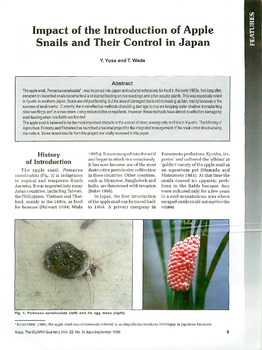Impact of the introduction of apple snails and their control in Japan

Citation
Yusa, Y.; Wada, T. (1999). Impact of the introduction of apple snails and their control in Japan. NAGA 22 (3): 9-13
The apple snail, Pomacea canaliculata, was imported into Japan and cultured extensively for food in the early 1980s. Not long after, escaped or discarded snails became feral and started feeding on rice seedlings and other aquatic plants. This was especially noted in Kyushu in southern Japan. Snails are still proliferating, but the area of damaged rice is not increasing as fast, mainly because of the success of snail control. Currently, the most effective methods of avoiding damage to rice are keeping water shallow, transplanting older seedlings and, in some cases, using molluscicides or repellents. However, these methods have almost no effect on damage by snail feeding when rice fields are flooded. The apple snail is believed to be the most important obstacle to the spread of direct-sowing culture of rice in Kyushu. The Ministry of Agriculture, Forestry and Fisheries has launched a national project for the integrated management of the snail under direct sowing culture of rice in Kyushu. The Ministry of Agriculture, Forestry and Fisheries has launched a national project for the integrated management of the snail under direct-sowing rice culture. Some recent results from this project are briefly reviewed in this paper.
Permalink
Date Available
Type
Publisher
Countries
Copyright
CC BY 4.0
Research Themes
Language